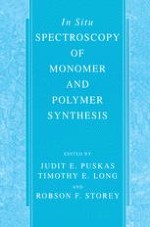2003 | OriginalPaper | Chapter
Investigation of High Temperature Isobutylene Polymerizations Utilizing Real-Time ATR-FTIR Spectroscopy
Mechanistic Considerations
Authors : Casey D. Stokes, Robson F. Storey
Published in: In Situ Spectroscopy of Monomer and Polymer Synthesis
Publisher: Springer US
Included in: Professional Book Archive
Activate our intelligent search to find suitable subject content or patents.
Select sections of text to find matching patents with Artificial Intelligence. powered by
Select sections of text to find additional relevant content using AI-assisted search. powered by
We have conducted a series of kinetic investigations on controlled cationic isobutylene (IB) polymerizations at high temperature, i.e., -10°C, monitored using in situ ATR-FTIR spectroscopy (ReactIR 1000, ASI Applied Systems,Inc.). The polymerizations were carried out in chlorinated solvents with boron trichloride as Lewis acid catalyst, and in the presence of the Lewis base (LB)2,4-lutidine, 2,6-lutidine, or 2,6-di-tert-butylpyridine, or the common-ionpre cursor, tetra-n-butyl ammonium chloride. Our goal was to produce nearly monodisperse polyisobutylene (PIB) with precise control over molecular weight and macromolecular architecture, including end groups. FTIR revealed subtle details of the polymerization at low monomer conversion that would have proved difficult to detect through the use of traditional, gravimetric analysis. NMR characterization of aliquots revealed a reversible, chain end dehydrochlorination reaction, which occurs at low monomer conversions. In situ NMR experiments were conducted to further the mechanism of this reaction.
